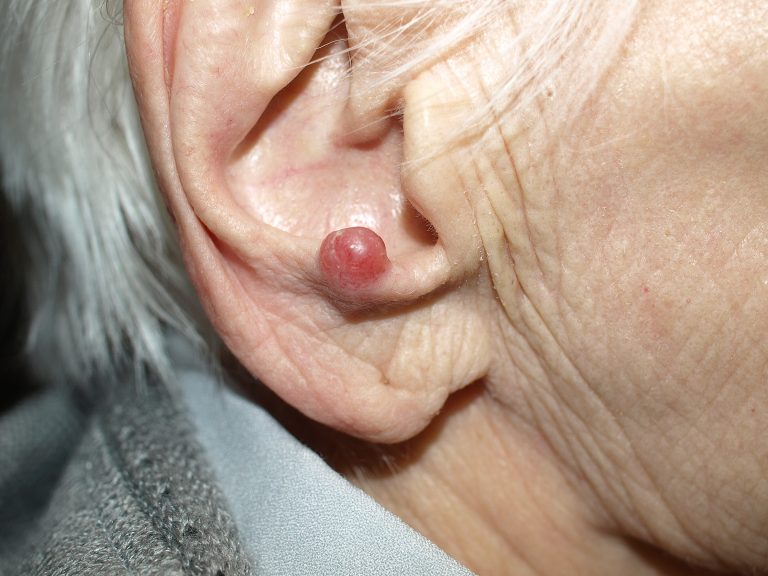
Researchers at Moffitt Cancer Center have partnered with investigators at the Dana-Farber Cancer Institute and Foundation Medicine to develop what Moffitt said was the largest descriptive genomic analysis to date of patients with Merkel cell carcinoma (MCC).
MCC is a rare aggressive skin tumor that is diagnosed in approximately 2,000 people each year in the U.S. That rarity has complicated efforts to study genetic factors leading to development of the disease, and how those factors correlate with response to therapy.
But the launch of several checkpoint inhibitors indicated for MCC has improved the once-dismal prognosis of patients with the disease, which previously had a 5-year survival rate of just 20%, according to Todd Knepper, PharmD, assistant member of the Department of Individualized Cancer Management at Moffitt, and the study’s first author.
Moffitt said investigators carried out a comprehensive genomic analysis of 317 patients with MCC, and also analyzed the outcomes of 57 MCC patients treated at the cancer center. The researchers also compared these genetic profiles to other skin cancers showing that Merkel cell polyomavirus-positive (MCPyV-positive) MCC resembles other viral cancers. By contrast, MCPyV-negative MCC resembles other neuroendocrine cancers.
According to results published in Clinical Cancer Research, the investigators found two distinct populations among the 317 MCC patients: Patients with a high tumor mutational burden (TMB) and those with a low TMB.
Of the patients with a high TMB, 94% had a UV-signature mutation in their tumor DNA and none of these patients had evidence of MCPyV. However, while patients with a low TMB did not have a UV-signature mutation, 63% of them showed evidence of MCPyV virus within their tumors.
Among both TMB-high and TMB-low tumor populations, mutations in the genes TP53 and RB1 were the most prevalent.
“While there are two distinct molecular subsets of this disease, interestingly, they exhibit similar response rates to checkpoint inhibitor therapy,” Andrew Brohl, M.D., assistant member of Moffitt’s Cutaneous Oncology Department and a co-corresponding author of the study, said in a statement.
Immunotherapies Show Effectiveness
Researchers found that immunotherapies were highly effective for patients with both a high TMB and a low TMB; 50% of patients with TMB-high/UV-driven tumors and 41% of patients with TMB-low/MCPyV-positive both responded to therapy.
The earlier the patients were treated with immunotherapy, the better they responded to therapy. The percent of MCC patients who responded to immunotherapy when given as their first treatment was 75%. But that response rate decreased to 39% for those treated with immunotherapy as their second therapy, and fell further to 18% for those treated as their third or later therapy.
Patients who expressed the biomarker PD-1 had a better response to immunotherapy than patients who did not express PD-1, the research team also observed.
The study used FoundationOne, Foundation Medicine’s comprehensive genomic profiling assay for solid tumor cancers, which detects substitutions, insertion and deletion alterations (indels), and copy number alterations in 324 genes and select gene rearrangements.
A precursor to FoundationOne® CDx , the first FDA-approved broad companion diagnostic that is clinically and analytically validated for solid tumors, FoundationOne is designed to test for solid tumor cancers that include non-small cell lung cancer (NSCLC), colorectal, breast, ovarian, and melanoma. FoundationOne is also designed to detect genomic signatures, including microsatellite instability and tumor mutational burden, using DNA isolated from formalin-fixed paraffin embedded (FFPE) tumor tissue specimens.
Before the Moffitt study, the largest analysis of MCC patients included fewer than 50 patients.
“This study represents the largest description of the genomic landscape of Merkel cell carcinoma,” Brohl declared. “The magnitude of this study provides a more definitive landscape of the disease, demonstrating the distinctive mutational spectra of MCPyV-positive/TMB-low and UV-driven MCC subgroup.”
The study was supported in part by a National Cancer Institute Cancer Center Support Grant (P30-CA076292), as well as by the Campbell Family Foundation, the DFCI Helen Pappas Merkel Cell Research Fund, and the Claudia Adams Barr Program in Cancer Research.






![AI Algorithm Could Reduce Breast Cancer Mammogram False Positive Rate The primary goal of the Paradigm Registry is to accelerate tumor profiling based on disease biology. [iStock/LilliDay]](https://www.insideprecisionmedicine.com/wp-content/uploads/2019/01/307-218x150.jpeg)






